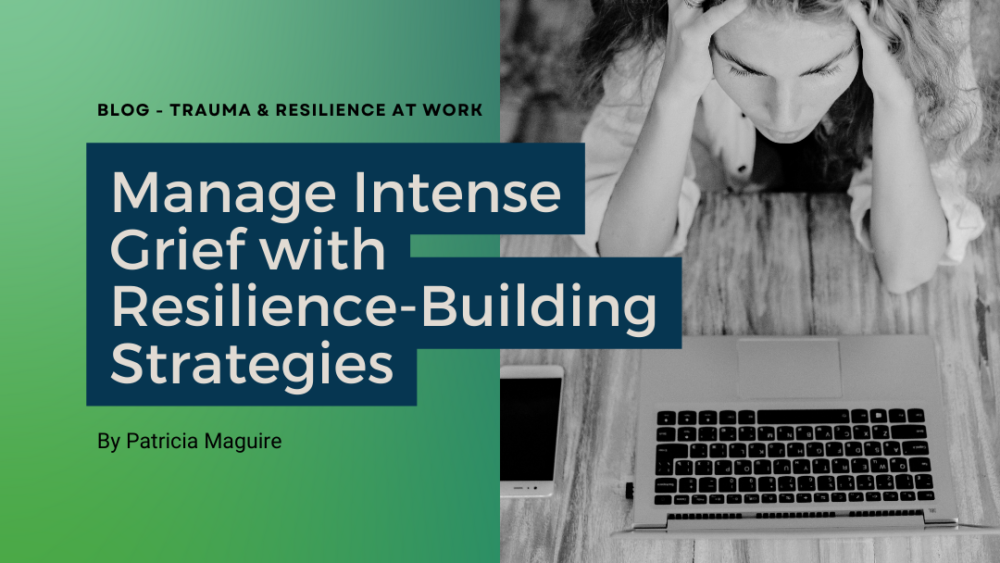My aunt recently likened grief to the waves of the ocean: sometimes grief shows up as small ripples, while other times it comes as a devastating tidal wave. I was hit with a grief tsunami yesterday. Losing my mom in December 2022 has left me heartbroken. I was (am) lost. I have recently been managing the task of doing a final clean out of my mom’s apartment before a new tenant moves in. While finishing the process, my grief knocked the wind out of me. I was wracked with sobs and literally fell to the floor. It was not a pretty sight – I was crying, sweating, very snotty, and gasping for breath. I was gutted.
I have often been considered “strong” by others; dependable, able to withstand a lot and come out shining on the other side. I prided myself on being strong as well. I have a dually diagnosed father (substance use disorder and mental illness), I am a breast cancer survivor, I survived a tumultuous IVF journey to bring us our son, and I am a first-generation college student. Losing my mom has shaken me up and made me afraid that I would fall apart without her. I feared that she was my superpower and losing her meant losing my ability to be strong, resilient, to survive (and thrive). The truth is that I did fall apart without my mom, but I am also learning that I can still be strong and resilient.
Over a year ago I made an important professional and personal decision to change jobs and join Corporation for a Skilled Workforce (CSW) specifically for their growing body of work advancing workplaces and workforces that are culturally responsive, trauma-informed, resilience-building, and supportive of mental well-being. For the first time in my career, I could wear my multiple hats – macro social worker, workforce development professional, and trauma survivor – all at once. You would think, with all that knowledge and training under my belt, I’d be amply prepared to survive the grief tsunami. The reality was that after losing my mom, I felt like a hypocrite. All I could think was how completely useless all my training seemed. It wouldn’t bring my mom back.
Thankfully, I was wrong. Shortly after being brought literally to my knees by grief, my self-care and resilience training kicked in. Instead of trying to repress or bury my grief like I previously would have, I let myself feel my grief and cry. Once the waves of pain eased up a little, I focused on my breathing, using techniques I had learned in yoga. I texted my boss that I needed to be offline for the rest of the afternoon. I splashed cold water on my face, wrapped myself in one of my mom’s sweaters, and went for a walk – or rather charged around the block! When I returned I did a few minutes of stretching and then did some more breathing exercises paired with some progressive muscle relaxation followed by some guided meditations.
Within two hours of the tsunami, I was able to function and pick up my son from daycare, but my self-care and resilience work was not done. It is an ongoing, iterative practice. I spent time that night playing with my son; I highly recommend that adults play more! I made time to go for a two-mile walk the next morning and have been committing to 2-3 walks a week. No one can go it alone though. I am learning to grow and lean on my support network; working again with a therapist to process my grief and trauma; and exploring and practicing different self-care and resiliency techniques. For example, I have plans to visit a smash room and I’m signed up for a basket weaving class for a creative outlet.
Below are some of the strategies that have been helpful for me in working through my grief and building my resiliency.
Calm Down in a Crisis with TIPP Skills
I had started working with a Cognitive-Behavioral Therapist months before my mom became sick. My therapist was helping me learn techniques and strategies to manage and lessen my anxiety. This included TIPP Skills to decrease the intensity of my emotions when in a crisis – like being hit with a grief tsunami. Using the below strategies can help calm your brain and body down so that other coping and resiliency skills can be utilized.
- T = Temperature – change your body temperature with cold water/compress.
- I = Intense Exercise – engage in exercise to match your intense emotions.
- P = Paced Breathing – focus on your breathing, I like to do a big belly inhale for a count of 3, hold, and then slowly exhale for a count of 9.
- P = Progressive Muscle Relaxation – focus on one muscle group at a time, tightening/tensing muscles and holding and then releasing and relaxing.
Understand the Science of Grief
Learning about the brain science behind my trauma and grief has helped me explain and legitimize what is going on in my brain and body. It has helped me try not to be as hard on myself for negative reactions and behaviors. In CSW’s Trauma and Resilience at Work Quick Guides, we explain how a healthy brain shows good activity in the frontal lobe where learning, executive functioning, etc. takes place. On the flip side, a brain experiencing emotional trauma shows a lot of activity at the base, home of the brain’s emergency response system, the amygdala. Essentially, a trauma brain is always in emergency response mode, scanning for and reacting to danger, rather than engaging in learning and other frontal lobe activities.
The good news is that the brain’s neuroplasticity (ability to change) goes both ways! Just as trauma can have a negative impact, building resilience can help us counterbalance with positive and healthy steps and behaviors.
The article As You Grieve, Your Brain Redraws Its Neural Map, explains how grief like other trauma has an impact on your brain. Understanding this can help explain and normalize what you are going through: You’re not crazy; your brain is rewiring itself, and you need time to feel whole again, reinvent your life, and plan a different future without your beloved. Knowing this can grant you more patience and self-compassion.
Use the TEAR Model to Work Through your Grief/Trauma
As Robert Frost once wrote, “the best way out is always through.” Of course, it is most definitely not the easiest way! Until recent years, I had always opted to push down my trauma and emotions – put them in an internal lock box of sorts. Unfortunately, I have learned that lock box inevitably bursts open and the trauma and emotions get out somehow – usually not in healthy ways. My therapist introduced me to the TEAR Model of Grief. It walks through the “tasks” we need to complete when we grieve. I always did like a to do list! We need:
- T = To accept the reality of the loss;
- E = Experience the pain of the loss;
- A = Adjust to a new life without the person;
- R = Reinvest in the new reality.
Practice Self-Care to Build Resiliency
Trauma and grief deplete us, and we need to counterbalance with ways to fill our resilience well. At CSW we stress the importance of different levels of resilience needed and that the responsibility is not solely on the individual. We present a Resilience Rainbow where the core is feeling safe and valued. Surrounding and protecting the core is what we can do personally, in our organizations and workplaces, and in our communities. Individuals do not exist in vacuums; therefore, sustainable change cannot be just the responsibility of individuals. We need to look at the systems we operate in. We need to shed our country’s push for rugged individualism. In reality, it is unhealthy, unproductive, and sets us up for failure.
The Olga Phoenix Project has some great wellbeing tools to help us think holistically about our self-care and resiliency strategies. The Self-Care Wheel breaks down self-care into six dimensions (physical, psychological, emotional, spiritual, personal, and professional) and provides suggestions and ideas in each. The Resilience Wheel approaches resilience from the point of views of Relationships (with self, loved ones, and community), Life Purpose (values, goals, and passions), and Self-Care (spirit, mind, body). Both tools help you to assess what areas you need to pay attention to and provide guidance to get specific with your strategies.
Trauma and grief can have a profound impact on a person’s mental, emotional, and physical well-being and the journey through to recovery is never easy or linear. I share my story to honor my mom’s legacy of love and strength, to let readers know that they are not alone in their journey.



Comments are closed.